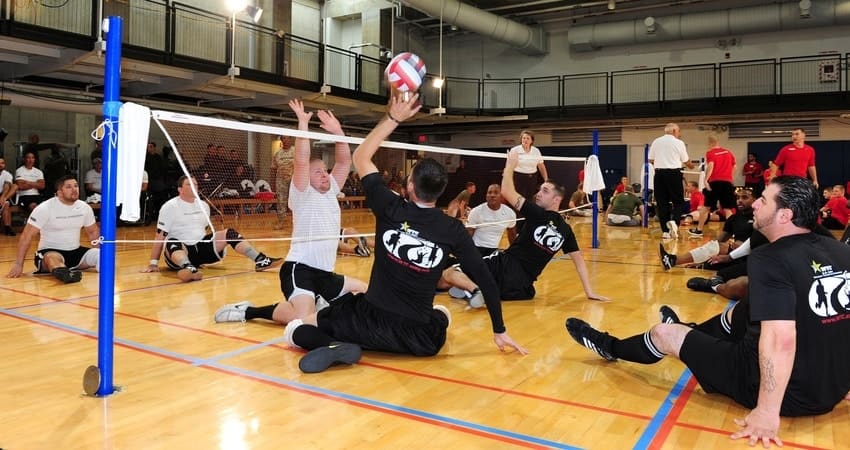The Olympic sports department strives to provide equal opportunities for all players, both the able-bodied and the differently-abled. In line with this inclusion, players with disabilities participate in their own games category known as Paralympic Games, the most popular among them being sitting volleyball, also known as Paralympic volleyball.
Sitting volleyball is a variation of regular standing volleyball suited to players with different physical impairments. Here, players must have at least a portion of their torso in contact with the ground during the game. In addition, this paralympic sport features a smaller court and a lower net.
Read on this article for all the essential information concerning Paralympic Volleyball.
How High Is the Net in Sitting Volleyball?
In sitting volleyball, the net sits at the height of 3.8 ft (1.15 m) for the men’s team, and at 3.4 ft (1.05m) for the women’s team. This is the height used in official competitions.
Given that sitting volleyball is meant for the physically impaired, certain modifications have to be made to perfectly meet the needs of the players. The height of the net is just one of such modifications.

Athletes with different disabilities such as spinal cord injuries, amputations, stroke, cerebral palsy, and brain injuries are the main participants in the sport. Since these athletes exhibit different levels of disability, they are placed into two categories labeled MD and D.
MD denotes the minimally disabled while D stands for the Disabled.
Under the MD category, players have lost only a part of their muscular strength and flexibility in one joint, which prevents them from qualifying for standing volleyball. On the other hand, players under the Disabled category have more drastic impairments and have lost almost ALL of their muscular strength and flexibility in one joint.
Each team is allowed only 2 MD players on their roster in the Paralympic Games. Only 1 of these players can be on the court at a time. These rules are to keep the teams competitive and make it fair for all teams.
Men and women participate in different categories of sitting volleyball. However, in some cases, teams can feature both men and women.
A common factor in Paralympic volleyball for both men and women, whether in MD or D category, is the small court measuring 32.8 x 19.6 ft (10 m x 6 m) with a 6.6 ft (2 m) attack line.
In addition, the net is smaller, measuring 32.8 x 2.6 ft (10 x 0.8 m), and is set at a significantly lower height. This is why the net sits at the height of 3.8 ft (1.15 m) and at 3.4 ft (1.05 m) for men and women, as mentioned above.
This low net setting allows Paralympic players to showcase their abilities without being impeded by a high net height.
Would you like to shop for our favorite recommended player products? Choose the item below and click to shop on Amazon.
How Is It Different From Regular Indoor Volleyball?
So, how different is Paralympic volleyball compared to indoor volleyball?
- Players’ posture: First off, just like the name says, you can tell that sitting volleyball involves seated players. This Paralympic sport is played with a part of the players’ lower bodies in contact with the ground, while for indoor volleyball, the players are in a standing posture.
- Court size: Sitting volleyball is played in a smaller court measuring 32.8 x 19.6 ft (10 x 6 m), while the standard court size for indoor volleyball is 59 x29.5 ft (18 x 9 m).
- Lower net: Because of the players’ disabilities, the net is set low to accommodate their muscular strength and flexibility. The men’s Paralympic team plays with the net set at 3.8 ft (1.15 m) while the women’s team plays at 3.4 ft (1.05 m). On the other hand, for indoor volleyball, men’s net height sits at 8.0 ft (2.43 m) while the standard height for women players is 7.3 ft (2.24 m).
- The players positioning: In paravolley, the position of each player is determined based on the position of their torsos in contact with the court’s surface. This means that the players’ hand(s) and or leg(s) may lie freely in the free zone or attack zone outside the court. This is different because with indoor volleyball the position of each player is determined and controlled by the position of their feet.
- Blocking the service: Players in sitting volleyball are allowed to block the service from the opponent, including over and beyond the net’s top. In indoor volleyball, blocking the serve from the opponent by reaching over the net isn’t allowed.
- Contact with the opponents: In paralympic volleyball, contact with the opponents under the net is allowed provided it doesn’t interfere with the opponent’s play or movements.
- The pace of the game: The smaller court and a low net make sitting volleyball a fast-paced game compared to indoor volleyball.
- Rules of attack execution: When executing any attack-hit in sitting volleyball, players aren’t allowed to lift their torsos from the court. If a player lifts their buttocks, it’s considered a “lifting” foul. On the other hand, players in standing volleyball are free to jump when executing a hit.
- Governing body: The international governing body for sitting volleyball is the World Paravolley. On the other hand, the international governing body for indoor volleyball is Federation Internationale de Volleyball (FIVB).

History of Paralympic Volleyball
The origin of sitting volleyball goes back to 1956 in the Netherlands. The Dutch Sports Committee first invented this sport as a rehabilitation sport for the injured soldiers. Two years after its invention, Dutch and German clubs held a sitting volleyball match.
The game blended the features of regular volleyball and a German sport known as Sitzball, played by seated players but with no nets in the court.
In 1976, standing volleyball appeared in the Toronto Paralympic Games as a demonstration sport for players with mobility impairments. During the subsequent Paralympic Games in Arnhem in 1980, both standing and sitting volleyball were featured as medal sports in the event.
Over the years, Paralympic volleyball continued to evolve, and in 1983, it was included in world championships at an event in Delten in the Netherlands. Here, only a men’s contest was held. Later in 1994, women’s sitting volleyball was featured in a championship held in Bottrop, Germany.
Since its first feature as a Paralympic Games in 1980, Sitting volleyball only featured male athletes. Women athletes didn’t have a chance to compete in the Paralympic Games until 2004 in Athens.
Over the years, sitting volleyball has evolved from being a mere rehabilitation sport for injured soldiers to a major sport in the Paralympic Games played by sitting players. It has offered a platform for the differently-abled players to exhibit their skills and capabilities.
Today, Paralympic volleyball accommodates players with different disabilities affecting their muscular strength and flexibility.
Athletes participating in this sport include but are not limited to:
- Amputees
- People living with Cerebral palsy
- Players with Spina Bifida
- People who have had a stroke
- People with brain injuries
Surprisingly, although sitting volleyball is for athletes with physical impairments, not all of them are unable to stand.
You may see some players stand up to cheer their team or celebrate victory. Such players are those whose lower bodies are functional, but other impairments disqualify them from otherwise participating.
Paralympic Volleyball continues to be one of the most popular Paralympic Games, attracting a huge fan base because it offers an enjoyable twist to the standard standing volleyball.
Bottom Line
Generally, sitting volleyball or Paralympic volleyball, as its name suggests, involves athletes engaging in volleyball but in a seated posture. It’s similar to other forms of volleyball, such as indoor and beach volleyball, with only some slight modifications.
The court size is smaller, the net height is low, and the players must have a part of their torsos in contact with the court during the game.
So, sitting volleyball is a slightly tweaked version of regular standing volleyball.
Would you like to learn more about other variations of volleyball? Check out our variation category page here.
Sources
- Wikipedia: Paralympic Games
- ParaVolley: SITTING VOLLEYBALL
- Sports Imports: REGULATION VOLLEYBALL NET HEIGHTS: A DEFINITIVE GUIDE
- Wikipedia: Fédération Internationale de Volleyball
- National Paralympic Heritage Trust: Sitting Volleyball
- Ontario Volleyball: Sitting Volleyball
- Topend Sports: Sitting Volleyball at the Paralympic Games
- International Paralympic Committee: Sitting Volleyball
- Paralympic: Sitting Volleyball
- NAU Campus Recreation: Sitting Volleyball Rules
- Paralympic School Day: Sitting Volleyball
- The Art of Coaching Volleyball: Basic Volleyball Rules and Terms
- Sports Monkey: INDOOR VOLLEYBALL RULES
- Sitting Volleyball: SITTING VOLLEYBALL RULES
Photo Credits
Feature image by Army Medicine on flickr.com: https://creativecommons.org/licenses/by/2.0/
Air Force vs Marines image by DVIDSHUB on flickr.com: https://creativecommons.org/licenses/by/2.0/
Army Team Warrior Care image by Army Medicine on flickr.com: https://creativecommons.org/licenses/by/2.0/
Recent Posts
Spikeball is a fairly new game that's becoming very popular and well-known. It's an easy option for casual settings because of how small the equipment is, how diverse the game options are, and is...
Have you ever seen what looks like a cross between a soccer game and a beach volleyball game? Chances are you were seeing footvolley in action. Footvolley is a variation of beach volleyball where...
